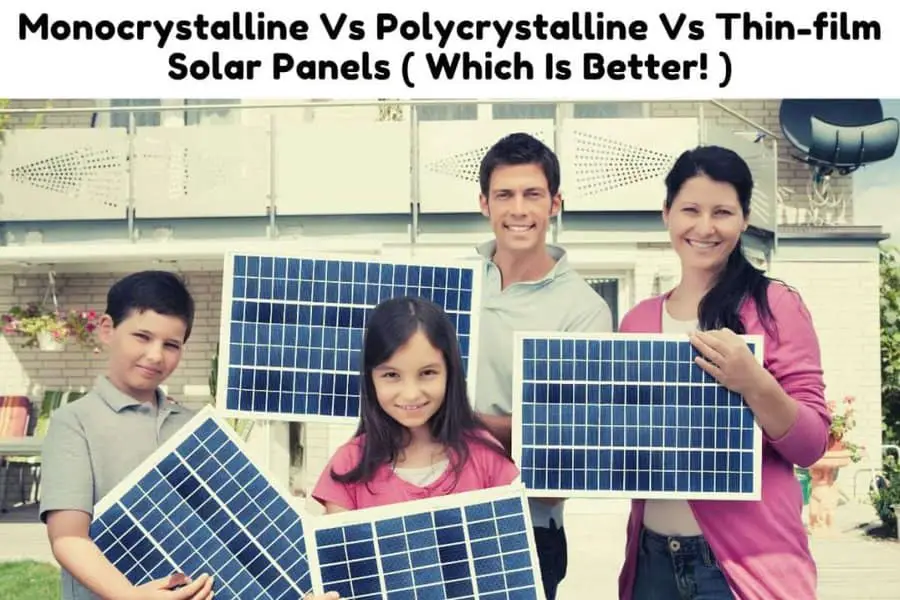After oxygen, silicon is the second most abundant element on Earth. 90% of the world’s solar panels are made using silicon as a raw material partly because it’s so abundant.
Silicon isn’t the only raw material used to make solar panels, however. There are solar panels made from other materials. How do the different solar panel technologies perform against each other? Today, we take a deep dive into solar cell performance to find out which type of solar panel is best.
If you’ve ever wondered which solar panel is the most efficient then this article will comprehensively answer your question.

What Are The 3 Types Of Solar Panels?
Solar panels are split into three main types, namely monocrystalline, polycrystalline, and thin-film. Monocrystalline and Polycrystalline are crystalline silicon-based. Thin-film panels use a variety of materials such as cadmium telluride.
On a side note! If you’re in need of a reliable and high-performance portable solar panel, We strongly recommend the Jackery SolarSaga 100W Portable Solar Panel (Amazon Link).
With a high conversion efficiency and foldable design, this solar panel is easy to transport and set up, making it perfect for outdoor activities like camping, hiking, and RV trips.

The US solar cell technology used in this panel ensures that you get the most efficient and reliable solar charging possible.
There is also a 60W option that is more affordable (Amazon Link)
Monocrystalline solar panels
Monocrystalline is the second most common type of solar panel after polycrystalline. They are made from a single silicon crystal hence the name monocrystalline abbreviated as Mono-Si or Mono c-Si.
Monocrystalline solar panels are made mostly through a technique known as the Czochralski method. A seed crystal is dipped into molten silicon. It’s then pulled out whereupon it solidifies into a monocrystalline ingot. The ingots are sliced into thin wafers that are then used to make solar cells.
Monocrystalline solar cells have a dark color because of the way light interacts with the silicon. The process of manufacturing monocrystalline is slower and more expensive which is why the solar panels are typically more expensive. Source
Polycrystalline solar panels
Polycrystalline has the largest market share of solar panels. Unlike monocrystalline, they are made from multiple silicon crystals hence why they’re poly or multi-crystalline abbreviated as Poly-Si or Mc-Si.
Polycrystalline solar panels are made using the same process as monocrystalline. The crucial difference is instead of pulling the ingot out to make a monocrystalline ingot, the molten silicon is left to cool and fragment.
The fragments are melted before being allowed to solidify into an ingot that is then cut into wafers that will eventually become solar cells.
Thin-film solar panels
Thin-film makes up 10% of the solar panel market. The first thin-film solar cells were used in the late 1970s to power calculators. If you’ve seen a calculator with a thin strip of brownish glass on the front then you’ve seen a thin-film solar cell.
Thin-film solar panels are made by depositing a layer of photovoltaic material on a substrate like metal, glass, or plastic. The layer can be nanometers thin, and it’s this thinness that makes the panel flexible and lightweight.
This is why thin-film is popular as a building integrated photovoltaic (BIPV) or solar panels that blend in well with their environment.
There are several types of thin-film technologies including cadmium telluride (CdTe), copper indium gallium diselenide (CIGS), and amorphous thin-film silicon (a-Si, TF-Si).
Now we’ve introduced you to monocrystalline, polycrystalline, and thin-film solar technology. But which is the most efficient and why?
What Type Of Solar Panel Is Most Efficient?
The most efficient type of solar panel is monocrystalline. They have an efficiency of up to 22%. The average efficiency of commercially available monocrystalline solar panels is 17%.
Solar panel efficiency is a measure of how much sunlight absorbed is converted into electricity. No solar panel is 100% efficient due to the Shockley–Queisser limit. This is a law of physics in terms of which the maximum theoretical efficiency a single-junction solar cell can reach is 33.7%. Source
Of all the commercially available solar panels, monocrystalline is the most efficient, followed by polycrystalline with thin-film being the least efficient.
| SOLAR PANEL | EFFICIENCY |
|---|---|
| Monocrystalline | 18-22% |
| Polycrystalline | 15-18% |
| Thin film | 7-18% |
Which Is Better Poly Or Mono Solar Panels?
Monocrystalline solar panels have a higher efficiency, maxing out at 22%. Polycrystalline has a lower efficiency at 18%. Typically, monocrystalline is the better solar panel as it has a higher energy yield.
Monocrystalline solar panels have some advantages over polycrystalline. They are made from a single silicon crystal which makes them more efficient than polycrystalline. What does better efficiency mean for you?
For one, you need fewer solar panels to produce more energy. Monocrystalline can mean the difference between buying 16 or 20 solar panels. While this might not seem like much, it can be critical where you have limited space and this is where having a higher efficiency solar panel shines.
A lower-efficiency solar panel will not give you the maximum energy yield you could get if you have a small space to work with. Also, monocrystalline solar panels perform better in low light and higher temperatures than polycrystalline.
That being said, however, monocrystalline solar panels are more expensive to make. This cost is passed on to you the end-user.
Which Solar Type Is Best?
Monocrystalline solar panels are the most efficient. This gives them a higher energy yield per square foot than other solar panel types like polycrystalline and thin-film.
Generally, monocrystalline is the better solar panel although this is not always so. There are some situations where you might want to opt for either polycrystalline or even thin-film solar panels.
For example, if you have enough space, you don’t necessarily need a high-performance solar panel. In this case, you could opt for polycrystalline solar panels. The advantage of this is you would spend less on panels.
For smaller projects like outside lighting or powering a tool shed, for example, it would not make much sense to pay a premium for monocrystalline solar panels. In this case, thin-film solar panels would work fine.
Thin-film is the cheapest solar panel and is ideal for small projects where you don’t need high-performance panels. They are unsuited for large projects as you need up to four times as many solar panels to produce the same amount of electricity as one poly or monocrystalline panel.
You should only opt for monocrystalline solar panels if you need the most amount of energy from the smallest available space.
In the future, we may have a fourth option in Perovskite solar panels. If they make it to production, these would have higher efficiency and would be much cheaper than monocrystalline.
